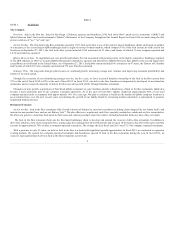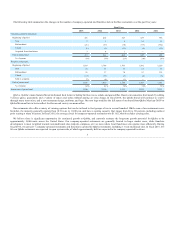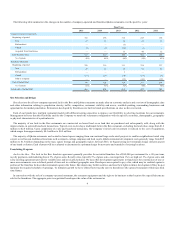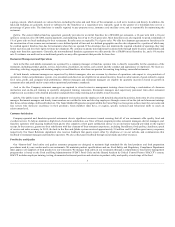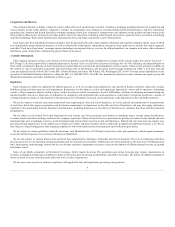Jack In The Box 2015 Annual Report Download - page 14
Download and view the complete annual report
Please find page 14 of the 2015 Jack In The Box annual report below. You can navigate through the pages in the report by either clicking on the pages listed below, or by using the keyword search tool below to find specific information within the annual report.
• impairment charges resulting from underperforming restaurants or decisions to curtail or cease investment in certain locations or markets;
• in new geographic markets where we have limited or no existing locations, the inability to successfully expand or acquire critical market presence
for our brands, acquire name recognition, successfully market our products or attract new customers;
• unique regulations or challenges applicable to operating in non-traditional locations, such as airports, college campuses, military or government
facilities;
• the challenge of identifying, recruiting and training qualified restaurant management;
• the inability to obtain all required permits;
• changes in laws, regulations and interpretations, including interpretations of the requirements of the Americans with Disabilities Act; and
• general economic and business conditions.
Although we manage our growth and development activities to help reduce such risks, we cannot assure that our present or future growth and development
activities will perform in accordance with our expectations. Our inability to expand in accordance with our plans or to manage the risks associated with our
growth could have a material adverse effect on our results of operations and financial condition.
Risks Related to Franchisee Financial and Business Operations. The opening and continued success of franchise restaurants depends on various factors,
including the demand for our franchises, the selection of appropriate franchisee candidates, the identification and availability of suitable sites, and
negotiation of acceptable lease or purchase terms for new locations, permitting and regulatory compliance, the ability to meet construction schedules, the
availability of financing, and the financial and other capabilities of our franchisees and developers. See “Growth and Development Risks” above. Despite our
due diligence performed during the recruiting process, we cannot assure you that franchisees and developers planning the opening of franchise restaurants
will have the business abilities or sufficient access to financial resources necessary to open the restaurants required by their agreements, or will prove to be
effective operators and remain aligned with us on operations, promotional or capital-intensive initiatives.
Our franchisees are contractually obligated to operate their restaurants in accordance with all applicable laws and regulations, as well as standards set forth
in our agreements with them. However, franchisees are independent third parties whom we cannot and do not control. If franchisees do not successfully
operate restaurants in a manner consistent with applicable laws and required standards, royalty, and in some cases rent, payments to us may be adversely
affected. If customers have negative perceptions or experiences with operational execution, food quality or safety at our franchised locations, our brands’
image and reputation could be harmed, which in turn could negatively impact our business and operating results.
With an increase in the proportion of Jack in the Box franchised restaurants, the percentage of our revenues derived from royalties and rents at Jack in the
Box franchise restaurants has increased, as has the risk that earnings could be negatively impacted by defaults in the payment of royalties and rents. As small
businesses, some of our franchise operators, may be negatively and disproportionately impacted by strategic initiatives, capital requirements, inflation, labor
costs, employee relations issues or other causes. In addition, franchisee business obligations may not be limited to the operation of Jack in the Box or Qdoba
restaurants, making them subject to business and financial risks unrelated to the operation of our restaurants. These unrelated risks could adversely affect a
franchisee’s ability to make payments to us or to make payments on a timely basis. We cannot assure that franchisees will successfully participate in our
strategic or marketing initiatives or operate their restaurants in a manner consistent with our concepts and standards. As compared to some of our competitors,
our Jack in the Box brand has relatively fewer franchisees who, on average, operate more restaurants per franchisee. There are significant risks to our business
if a franchisee, particularly one who operates a large number of restaurants, encounters financial difficulties or fails to adhere to our standards and projects an
image inconsistent with our brands.
Risk Relating to Competition, Menu Innovation and Successful Execution of our Operational Strategies and Initiatives. As part of our long term business
plan, in addition to growth through development of new restaurants, we are focused on increasing same-store sales and average unit volumes. These plans are
subject to a number of risks and uncertainties, including risks related to competition, menu innovation and the successful execution of our operational
strategies and initiatives. The restaurant industry is highly competitive with respect to price, service, location, personnel, advertising, brand identification
and the type, quality and innovativeness of menu items and new and differentiated service offerings There are many well-established competitors. Each of
our restaurants competes directly and indirectly with a large number of national and regional restaurant chains, as well as with locally-owned and/or
independent quick-service restaurants, fast-casual restaurants, casual dining restaurants, sandwich shops and similar types of businesses. The trend toward
convergence in grocery, deli and restaurant services has and may continue to increase the number of our competitors. Such increased competition could
decrease the demand for our products and negatively affect our sales and profitability. Some of our competitors have substantially greater financial,
marketing, operating and other resources than we have, which may give them a competitive advantage. Certain of our competitors have introduced a variety
of new products
12


